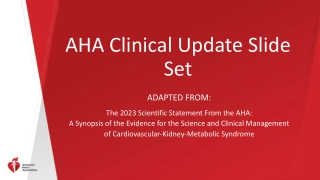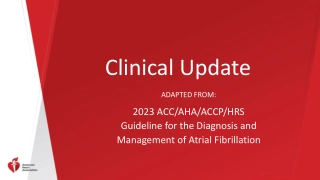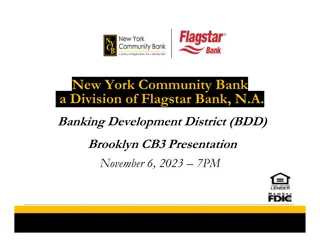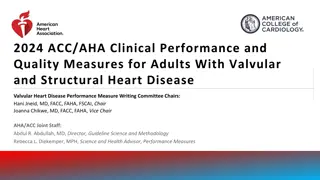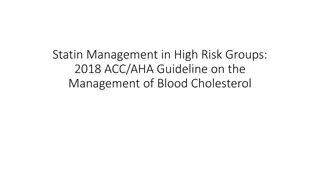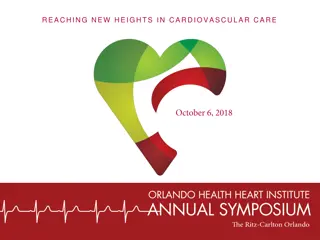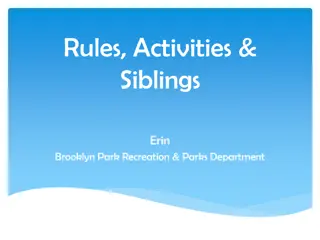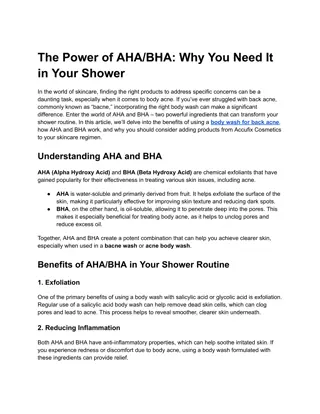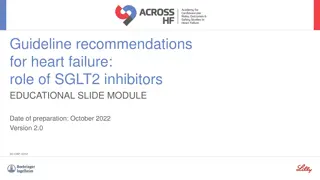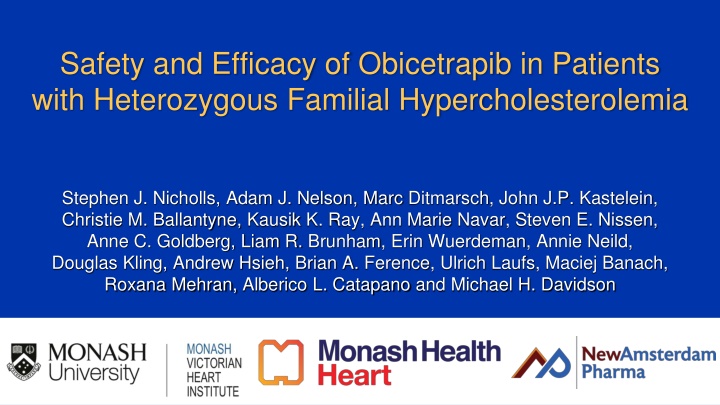
Safety and Efficacy of Obicetrapib in Patients with Heterozygous Familial Hypercholesterolemia Study
This study evaluates the safety and efficacy of obicetrapib as an adjunct to lipid-modifying therapies in patients with heterozygous familial hypercholesterolemia (HeFH) who have suboptimal LDL-C control. Obicetrapib, a cholesteryl ester transfer protein (CETP) inhibitor, aims to improve atherogenic lipid parameters in HeFH patients at risk for premature cardiovascular disease. The study design includes randomized, double-blind, placebo-controlled trials with main inclusion criteria of HeFH diagnosis and baseline LDL-C levels of 70mg/dL. Primary endpoint focuses on the percent change in LDL-C from baseline to day 84, with secondary endpoints examining changes in lipid parameters and the percentage of patients achieving LDL-C
Download Presentation

Please find below an Image/Link to download the presentation.
The content on the website is provided AS IS for your information and personal use only. It may not be sold, licensed, or shared on other websites without obtaining consent from the author. If you encounter any issues during the download, it is possible that the publisher has removed the file from their server.
You are allowed to download the files provided on this website for personal or commercial use, subject to the condition that they are used lawfully. All files are the property of their respective owners.
The content on the website is provided AS IS for your information and personal use only. It may not be sold, licensed, or shared on other websites without obtaining consent from the author.
E N D
Presentation Transcript
Safety and Efficacy of Obicetrapib in Patients with Heterozygous Familial Hypercholesterolemia Stephen J. Nicholls, Adam J. Nelson, Marc Ditmarsch, John J.P. Kastelein, Christie M. Ballantyne, Kausik K. Ray, Ann Marie Navar, Steven E. Nissen, Anne C. Goldberg, Liam R. Brunham, Erin Wuerdeman, Annie Neild, Douglas Kling, Andrew Hsieh, Brian A. Ference, Ulrich Laufs, Maciej Banach, Roxana Mehran, Alberico L. Catapano and Michael H. Davidson
Disclosures Research support: AstraZeneca, Amgen, Anthera, Eli Lilly, Esperion, Novartis, Cerenis, The Medicines Company, Resverlogix, InfraReDx, Roche, Sanofi- Regeneron and LipoScience Consulting and honoraria: AstraZeneca, Akcea, Eli Lilly, Anthera, Omthera, Merck, Takeda, Resverlogix, Sanofi-Regeneron, CSL Behring, Esperion, Boehringer Ingelheim, Cyclarity, Daiichi Sankyo, CSL Seqirus, Vaxxinity
Background Heterozygous familial hypercholesterolemia (HeFH) is associated with an increased risk of premature CVD. Many patients with HeFH fail to achieve LDL-C targets despite use of existing lipid lowering therapies. Obicetrapib is a cholesteryl ester transfer protein (CETP) inhibitor which reduces atherogenic lipid parameters and raises HDL-C when added to statins.
Objective To evaluate the efficacy, safety and tolerability of obicetrapib, as an adjunct to maximally tolerated lipid-modifying therapies, in patients with HeFH and suboptimal LDL-C control.
Study Design Main Inclusion Criteria HeFH diagnosed by Genetic confirmation WHO criteria / Dutch Clinical Network Simon Broome criteria On maximally tolerated lipid lowering therapy LDL-C 70mg/dL TG 400mg/dL Study Design: Randomized, double-blind, placebo-controlled Patients (n=354) HeFH 18 years Baseline LDL-C: 70 mg/dL Obicetrapib 10mg (n=236) Safety FU Placebo (n=118) Safety FU 1 2 1 3 30 4 84 5 6 7 8 Visit: Days: -14 to -1 180 270 365 +35 Exclusion Criteria CV event in the last 3 months HoFH Uncontrolled hypertension Eligibility Labs, PK Safety Labs, PK Safety Labs, PK Safety Labs, PK Safety Labs, PK Safety Labs, PK Safety Labs, PK Safety 1 endpoint Key 2 endpoint Primary endpoint: percent change in LDL-C from baseline to day 84 Secondary endpoints: change in LDL-C at day 365 and changes in other lipid parameters and percent of patients achieving a LDL-C <100 mg/dL at day 84
Demographics Placebo (N=118) 56.6 55.1 93.2 29.6 22.0 83.9 67.8 50.0 22.6 Obicetrapib (N=236) 57.0 53.0 92.8 29.3 19.9 88.6 78.8 53.8 14.0 Parameter Age (yrs) Females (%) White (%) BMI (kg/m2) Diabetes (%) Statin use(%) High intensity statin use (%) Ezetimibe use (%) PCSK9 inhibitor use (%)
Baseline Lipid Parameters Placebo (N=118) Obicetrapib (N=236) Parameter LDL-C (mg/dL) 119.9 123.4 Non-HDL-C (mg/dL) 146.7 148.4 Apolipoprotein B (mg/dL) 105.3 107.2 HDL-C (mg/dL) 50.2 53.2 Triglycerides (mg/dL) 139.9 133.6 Lp(a) (nmol/L) 34.9 45.8
Percent Change in LDL-C with Obicetrapib Placebo-adjusted Percent Change in LDL-C Percent Change in LDL-C 10.3 5.9 4.0 4.8 Percent Change LDL-C LS Mean Change (%) 0.3 -31.1 -32.3 -33.5 -36.1 -36.3 -39.6 Placebo Obicetrapib -41.5 Both P<0.0001 from baseline Day Day
Individual Changes in LDL-C with Placebo and Obicetrapib at Day 84 Placebo Obicetrapib Mean Change from Baseline (%) Mean Change from Baseline (%) 3% achieved LDL-C lowering >50% 34% achieved LDL-C lowering >50%
Percent of Patients Achieving LDL-C Goals Placebo Obicetrapib Percent
Percent Change in non-HDL-C and ApoB Placebo-adjusted Percent Change in non-HDL-C Placebo-adjusted Percent Change in ApoB LS Mean Change (%) LS Mean Change (%) -24.4 -24.4 -34.5 -25.8 -37.5 -25.8 -34.5 -37.5 Day Day
Percentage Change in HDL-C and Triglycerides Placebo-adjusted Percent Change in HDL-C Placebo-adjusted Percent Change in Triglycerides 138.7 121.4 LS Mean Change LDL-C LS Mean Change (%) -5.1 -11.7 Day Day
Percent Change in LDL Particles and hsCRP Placebo-adjusted Percent Change in LDL Particles at Day 180 Placebo-adjusted Percent Change in hsCRP Percent Change Percent Change -52.5 -8.8 -102.4 -16.8 LDL Particles Day
Percent Changes in Lp(a) Placebo-adjusted Percent Change in Lp(a) Individual Percent Changes in Lp(a) Placebo % Change Lp(a) % LS Mean Change 3% achieved >50% lowering Obicetrapib % Change Lp(a) -45.9 -45.9 -54.3 -54.3 38% achieved >50% lowering Day
Safety and Tolerability Placebo (N=118) Obicetrapib (N=236) Parameter Treatment emergent adverse events (%) 70.3 63.7 Study drug related adverse events (%) 6.8 4.3 Mild (%) 4.2 2.1 Moderate (%) 2.5 2.1 Severe (%) 0 0 Adverse events leading to drug discontinuation (%) 6.8 4.3 Adverse events leading to death (%) 1.7 1.3 AEs experienced by >5% of patients included influenza, hypertension, nasopharyngitis, diarrhea, upper respiratory tract infection, back pain, headache and fatigue with no difference between the treatment groups.
Events of Special Interest Placebo (N=118) Obicetrapib (N=236) Parameter AST or ALT >3x ULN (%) 0 0 Bilirubin >2x ULN (%) 1.7 0 CK >5x ULN (%) 3.4 1.3 New diabetes or worsening glycemic control (%) 22.0 20.5 HbA1c increase >0.5% from baseline (%) 5.1 3.4 eGFR <30 or >25% decrease eGFR (%) 8.5 4.3 Macular degeneration (%) 0 0 Cardiovascular events (%) 4.2 2.6
No Significant Change in Blood Pressure with Obicetrapib Systolic BP Diastolic BP Change Systolic BP (mmHg) Change Systolic BP (mmHg) Placebo Obicetrapib Placebo Obicetrapib 0.3 0.3 0.1 -0.1 -0.5 -0.4 -0.6 -0.6 -0.2 -1.6 -1.3 -0.2 -0.7 -0.7 -0.7 -1.2 -1.3 -1.4 -1.7 -1.8 Day Day
Limitations The study evaluated the effect of obicetrapib for 365 days, the effect of longer treatment requires further evaluation. The Lp(a) lowering was observed in a cohort who were not required to have elevated levels at study entry. Additional studies will evaluate the impact of obicetrapib in individuals with elevated Lp(a) levels. Whether treatment with obicetrapib results in a reduction in cardiovascular events remains to be determined.
Summary Obicetrapib reduced placebo-adjusted LDL-C 36.3% at day 84 and 41.5% at day 365 with >50% reductions observed in 34% of patients Obicetrapib resulted in placebo-adjusted reductions in Lp(a) by 54.3%, independent of lowering atherogenic lipid parameters and raising HDL-C. Obicetrapib was well tolerated with no safety concerns. The longer-term effect of obicetrapib on cardiovascular outcomes is currently being evaluated in the PREVAIL trial. The findings suggest that obicetrapib has considerable promise as an approach to more effective lipid control in high CV risk patients.

